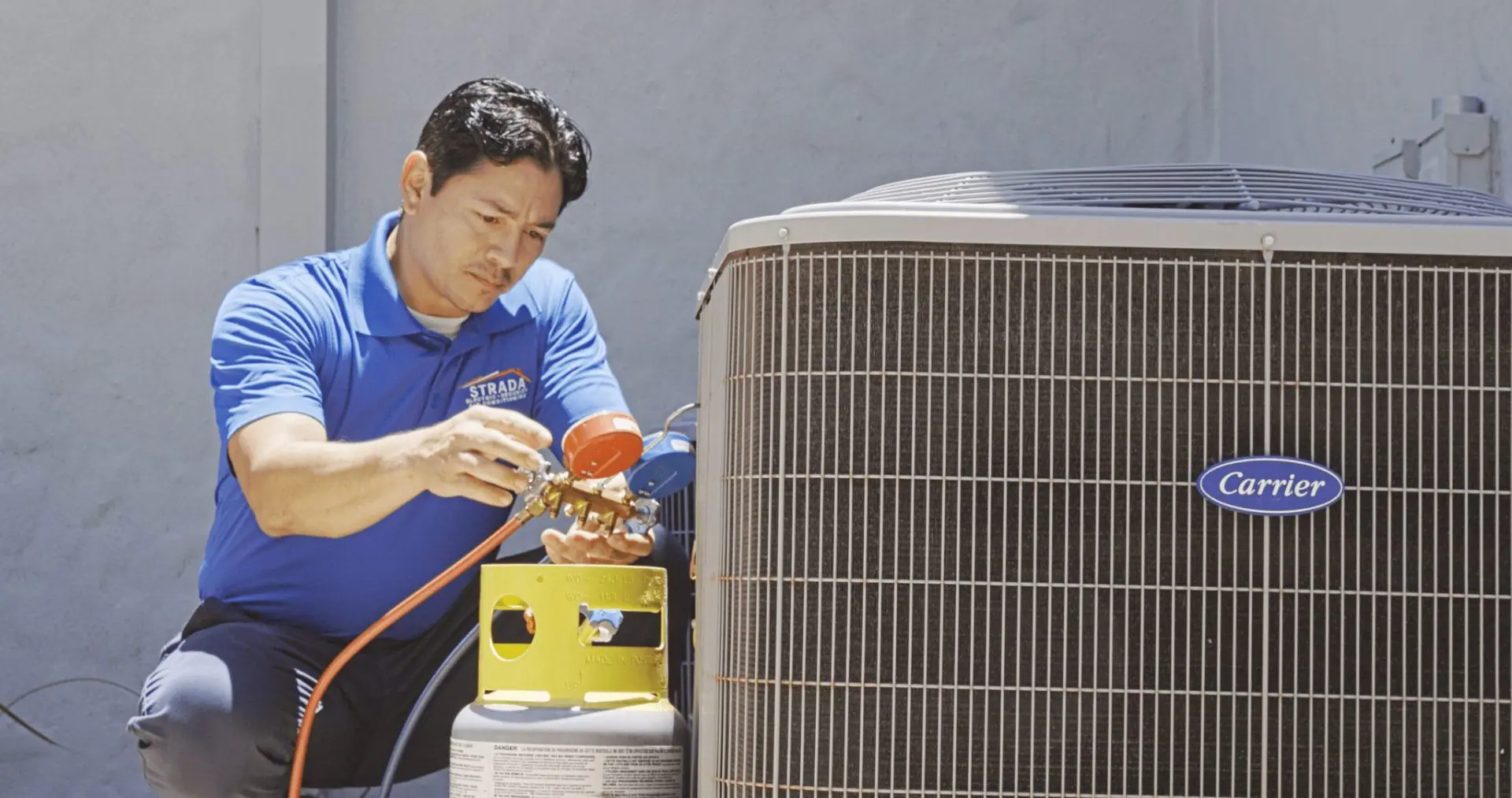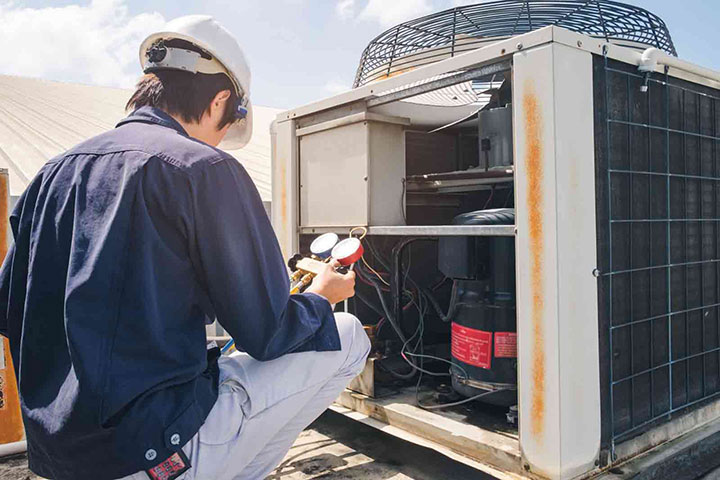How a Heatpump and Heating System Interact to Maximize Your Home's Home heating Efficiency
Recognizing exactly how a heatpump and heater interact is necessary for home owners seeking efficient heating remedies. Each system has its toughness, giving a well balanced technique to home convenience. The heatpump masters modest temperature levels, while the furnace supplies fast heat during severe cold. This harmony not just minimizes energy expenses however likewise improves the life expectancy of both home appliances. What variables influence this partnership, and just how can home owners maximize their advantages?
Recognizing Warm Pumps: Exactly How They Work
Although many individuals might be not familiar with their internal functions, warm pumps play a vital duty in contemporary furnace. These gadgets run by transferring warmth from one place to an additional, making use of the principles of thermodynamics. In cooler months, a heat pump essences warmth from the outdoors air, ground, or water, and transfers it inside to warm the living area. On the other hand, throughout warmer months, it can turn around the procedure, functioning as an a/c by eliminating heat from inside to the outside.Heat pumps are composed of an evaporator, compressor, condenser, and expansion valve. The cooling agent within the system takes in warm as it vaporizes at reduced temperature levels and stress. The compressor after that increases the pressure and temperature of the refrigerant, permitting it to release heat as it condenses. This effective process can considerably reduce power consumption contrasted to traditional home heating techniques, making heatpump a lasting selection for climate control in homes.
The Role of Furnaces in Home Home Heating
Furnaces play an important duty in home heating by offering a dependable resource of warmth throughout the chillier months. They operate by producing heat with combustion or electric resistance, distributing it throughout the home by means of air ducts or radiant systems. The performance of a furnace is often determined by its Annual Fuel Use Effectiveness (AFUE) ranking, which indicates how successfully the device converts gas right into heat.Furnaces can make use of different energy sources, consisting of gas, oil, electricity, or propane, allowing house owners to choose one of the most suitable choice for their requirements. Unlike heat pumps, which may struggle in extreme cool, furnaces preserve consistent efficiency, ensuring that interior temperature levels remain comfortable no matter exterior conditions. In addition, modern-day heaters often come equipped with advanced modern technology, such as clever thermostats and variable-speed blowers, boosting their performance and responsiveness. This versatility makes heating systems an important component in all-inclusive home heating techniques.

Advantages of Utilizing Both Equipments Together
Combining the staminas of both heaters and warm pumps can lead to an extra reliable and reliable home heating remedy. Using both systems permits house owners to capitalize on the heat pump's power performance throughout milder temperatures while relying upon the heater for more extreme cold problems. This double method can significantly reduce power costs, as heatpump consume much less electrical power than standard home heating approaches when temperatures are moderate.Additionally, making use of both systems together can boost convenience levels in the home. Heatpump can provide regular, also heating, while furnaces can promptly increase ambient temperature levels when required. Moreover, the assimilation of both systems can expand the life expectancy of tools by decreasing deterioration on each system, as they share the work. Ultimately, house owners can appreciate a well balanced, affordable heating service that changes perfectly to varying climate condition, making sure a warm and welcoming home throughout the winter season months.
Just How Heat Pumps and Furnaces Enhance Each Other
When homeowners incorporate heatpump and heaters, they produce a complementary heating unit that maximizes efficiency and convenience. Warm pumps run by moving warm from the outdoors air or ground, making them extremely effective in moderate environments. They excel throughout milder temperature levels, offering affordable home heating. Conversely, heaters create warm via burning or electrical resistance, supplying solid, instant warmth during severe cool conditions.The mix of these 2 systems permits vibrant adjustments based upon temperature changes. During warmer months or milder wintertime days, the warmth pump can take the lead, conserving energy and minimizing expenses. As temperatures decrease, the heater can seamlessly engage, ensuring regular heat throughout the home. This synergy not just enhances power use yet likewise enhances the life expectancy of both systems, as each system operates within its perfect efficiency range. Together, they develop a balanced environment that adapts to varying environment demands.
Maximizing Efficiency: Tips for Homeowners
Property owners can enhance their home heating efficiency with several sensible methods. Establishing a routine upkeep timetable, integrating clever thermostat technology, and carrying out efficient insulation and securing services are vital steps. These actions not just boost convenience but likewise reduce power expenses.
Routine Upkeep Schedule
To ensure maximum heating effectiveness, developing a regular upkeep schedule is crucial for any type of home. Home owners need to focus on regular assessments of both heatpump and heaters to identify peak performance. This consists of transforming air filters every one to 3 months, as clogged filters can considerably reduce effectiveness. Additionally, scheduling expert upkeep at the very least yearly permits specialists to recognize and resolve possible problems prior to they intensify. Home owners should additionally cleanse the heatpump's outdoor unit to stop particles build-up that can prevent air movement. By adhering to a routine maintenance routine, home owners not only enhance their heating systems' effectiveness however likewise expand their lifespan, causing higher convenience and lowered power prices throughout the colder months.
Smart Thermostat Integration
Incorporating a clever thermostat right into a home heater can substantially improve power efficiency, specifically as it enables accurate control over temperature setups. These tools can discover the property owner's timetable and preferences, instantly changing the temperature level to enhance comfort while decreasing energy use. As an example, they can lower home heating during times when the home is empty, minimizing unneeded usage. Numerous clever thermostats additionally provide real-time power usage data, making it possible for house owners to make informed decisions about their home heating practices. In addition, remote gain access to via smartphone apps permits users to change settings from anywhere, ensuring the home is cozy upon return. Overall, wise thermostat combination not just improves convenience yet considerably adds to energy financial savings and efficiency.
Insulation and Sealing Solutions
Smart thermostats play an essential duty in power efficiency, however their effectiveness can be significantly improved by correct insulation and sealing options. Home owners ought to focus on shielding floorings, attic rooms, and wall surfaces to decrease warmth loss. Top notch insulation materials, such as spray foam or fiberglass, can significantly boost thermal resistance. In addition, securing gaps around air ducts, windows, and doors protects against cool air seepage and warmth escape. Weatherstripping and caulking work methods for dealing with these leaks - heat pump installation ooltewah tn. Normal inspections for air leakages, in addition to the usage of blower door examinations, can assist determine problem areas. By purchasing insulation and sealing, homeowners can maximize the efficiency of their heater, inevitably bring about lowered power usage and reduced utility costs
Typical Misconceptions Concerning Warmth Pumps and Furnaces
What misconceptions surround heatpump and heating systems? Several people incorrectly believe that heatpump are ineffective in chillier climates. Actually, modern-day warm pumps are made to run efficiently even in reduced temperatures, providing dependable heating throughout winter season. Another usual myth is that heating systems are constantly much more reliable than warm pumps. Nonetheless, this relies on the certain energy resources and efficiency rankings of the devices concerned. Some might also believe that utilizing both systems concurrently is unneeded, however as a matter of fact, this mix can optimize heating performance, specifically during extreme weather. Additionally, individuals often presume that warmth pumps need constant maintenance, when in fact, they have comparable maintenance requires to typical heating systems. By unmasking these misconceptions, property owners can make even more informed decisions regarding their heating alternatives, ultimately causing boosted convenience and energy performance in their homes.
Maintenance Factors To Consider for Combined Systems

Frequently Asked Questions
Can Warmth Pumps Job Efficiently in Incredibly Cold Climates?
Heatpump can battle in exceptionally cold climates because of reduced performance and warmth removal limitations. Advancements in technology have actually led to versions made for better performance in such problems, boosting their viability in harsh atmospheres.
For How Long Do Heat Pumps and Furnaces Typically Last?
Heatpump normally last 15 to twenty years, while heating systems have a life expectancy of 15 to thirty years. Routine upkeep can extend their long life, guaranteeing effective operation and decreasing the need for premature substitutes.

What Is the Ordinary Price of Installing Both Equipments?
The average cost of setting up both a heatpump and a furnace normally varies between $5,000 to $10,000 - heat pump replacement ooltewah tn. Aspects affecting this price consist of system size, installation complexity, and local labor prices
Are There Tax Obligation Motivations for Making Use Of Energy-Efficient Home Heating Systems?
Lots of property owners ask about tax obligation motivations for energy-efficient furnace. Numerous federal and state programs usually offer refunds or credit scores, encouraging the adoption of sustainable innovations to reduce energy usage and promote environmental obligation.
Just how Do I Choose the Right Size Warm Pump and Heating System?
Selecting the appropriate size warm pump and heating system includes determining the home's square video footage, taking into consideration insulation high quality, and reviewing neighborhood environment. Consulting a professional can guarantee perfect system performance and power performance based on specific requirements. furnace replacement. Comprehending exactly how a warm pump and furnace work with each other is crucial for homeowners looking for efficient heating remedies. In cooler months, a heat pump removes heat from the outdoors air, ground, or water, and transfers it inside your home to warm the living space. When homeowners integrate warm pumps and furnaces, they produce a complementary heating system that maximizes performance and comfort. Heat pumps run by transferring warm from the outdoors air or ground, making them highly reliable in modest environments. Warm pumps can have a hard time in extremely cool climates due to minimized effectiveness and heat removal go restrictions